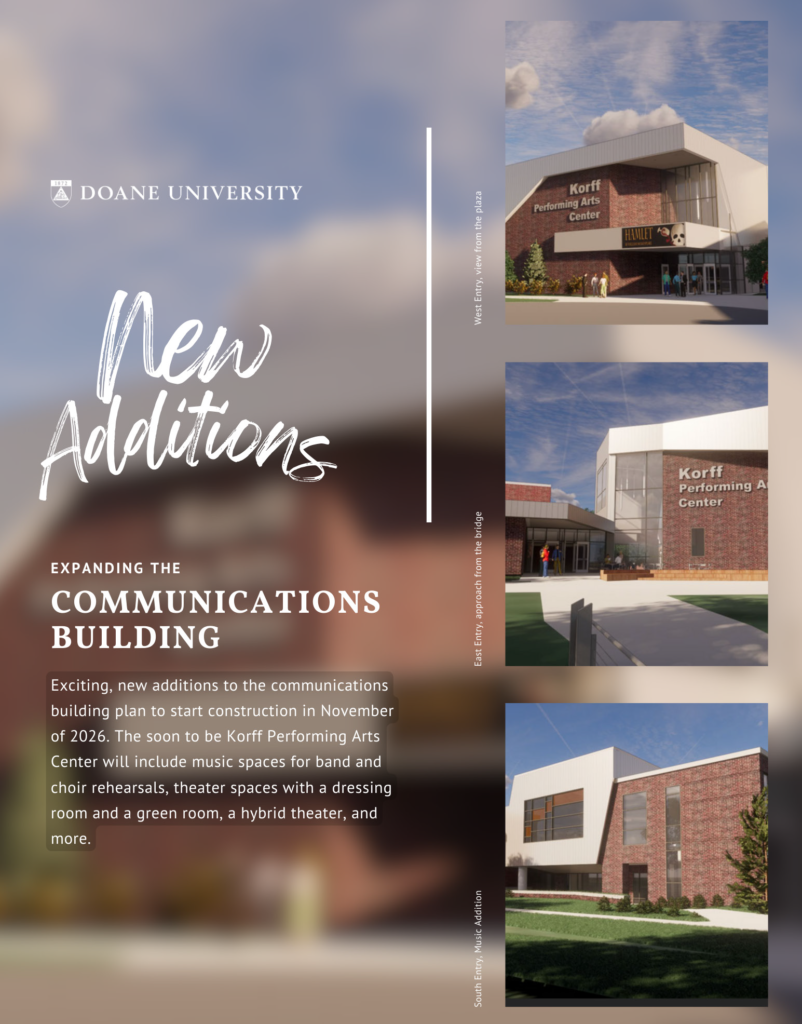
Updated Oct. 26, 2024
The Communications Building at Doane University, standing tall for 54 years, is about to undergo a significant transformation. As part of Doane’s 2023-2026 Strategic Plan, the building will be expanded by 47,492 square feet and renovated by 8,820 square feet to create a state-of-the-art Performing Arts Center (PAC). This project, which President Roger Hughes says has been 15 years in the making, will benefit both the Theatre and Music departments, establishing a hub for the performing arts on campus.
The design of the expansion was entrusted to the Clark & Enersen firm, whose portfolio includes Kiewit Hall at the University of Nebraska – Lincoln, Patriot Park in Kearney, and the Blair Public Library and Technology Center. New additions to the PAC will include a piano and recording studio, practice rooms, band rehearsal spaces, a mini-amphitheater, dressing rooms, and a 220-seat theater with a thrust stage and fly loft, among other upgrades. The expansion will not only modernize the facilities but will also bring the Theatre and Music departments closer together, creating shared spaces like lounges, concessions, and a lobby.
Dr. Andy Feyes, Director of Instrumental Music, describes the Performing Arts Center as having three main components. The first is the expansion of the music department, extending south behind the current building towards Doane Lake, though it won’t go beyond the library or east toward the Lied Science Building. The second component is the renovation and modernization of existing spaces like choir and band rooms and offices. Finally, the new theater will extend north towards the Communications Building parking lot and connect to Heckman Auditorium via a new lobby.
“When patrons or alumni return to campus for a theater production or a music performance, they will know without a doubt that Doane University is a place where beautiful art and music is made,” Feyes said.
Professor of Theatre Jeff Stander also welcomes the PAC as a solution to the limitations of the current Whitcomb Conservatory, which he describes as “bursting at the seams.” The new Multiform Theatre will be a highlight, allowing for more flexible and innovative staging.
“As the name suggests, it will be much easier to reorient the audience vs. performance space relationship,” Stander said.
Theatre Design Tech courses will be updated to take advantage of the new space and modern equipment in the Multiform Theatre. However, Stander reassures that the Conservatory won’t be demolished or abandoned. Offices, the costume shop, classrooms, rehearsal spaces and storage will remain in the Conservatory, with only the scene shop moving to the new PAC.
Despite the excitement, the new theater will occupy a significant portion of the Communications Building parking lot.
“When you look at other campuses they have a center and Doane doesn’t have that,” President Hughes said.
He views the PAC as the first step in a broader reimagining of campus, with potential expansions for the Business and Engineering departments on the horizon. This is all part of a larger vision for Doane’s campus which aims to expand current departments, create a central hub, and offer more resources for students. Hughes has also begun preliminary discussions about Gaylord Hall, acknowledging that the building’s age and foundation could pose future problems. While the future of Gaylord remains uncertain, Hughes is also considering plans for Butler Gymnasium, though those may not materialize during his time at Doane.
“One of the best parts of being a small university is our community,” Hughes said.
Emphasizing the collaboration between faculty during meetings about the PAC and other projects. He praised the forward-thinking and collaborative efforts of the Music and Theatre departments, which have been instrumental in shaping the project alongside architects and consultants. Brian Flesner, Director of Facilities Operations & Construction Projects, echoed Hughes’ sentiment, noting the faculty’s focus on the student experience while developing the PAC.
“I cannot wait to turn this over and open the doors so students, faculty, and staff can experience this new learning environment,” Flesner said.
Construction for the PAC is expected to begin by November of this year, with the project anticipated to be completed by December 2026. The music department’s expansion is scheduled for completion by June 2026, followed by the renovation and theater addition by the end of that year. Both faculty and students are excited about the new possibilities the PAC will bring, marking a long-awaited enhancement to Doane’s performing arts community.
Corrections: A previous version of this article incorrectly stated that the new PAC will feature a CAD lab and costume shop. It also incorrectly identified Jeff Stander as “Associate Professor” rather than “Professor.” The Owl regrets the errors.
